tow Citroen DS4 RHD 2013.5 1.G User Guide
[x] Cancel search | Manufacturer: CITROEN, Model Year: 2013.5, Model line: DS4 RHD, Model: Citroen DS4 RHD 2013.5 1.GPages: 400, PDF Size: 31.86 MB
Page 88 of 400
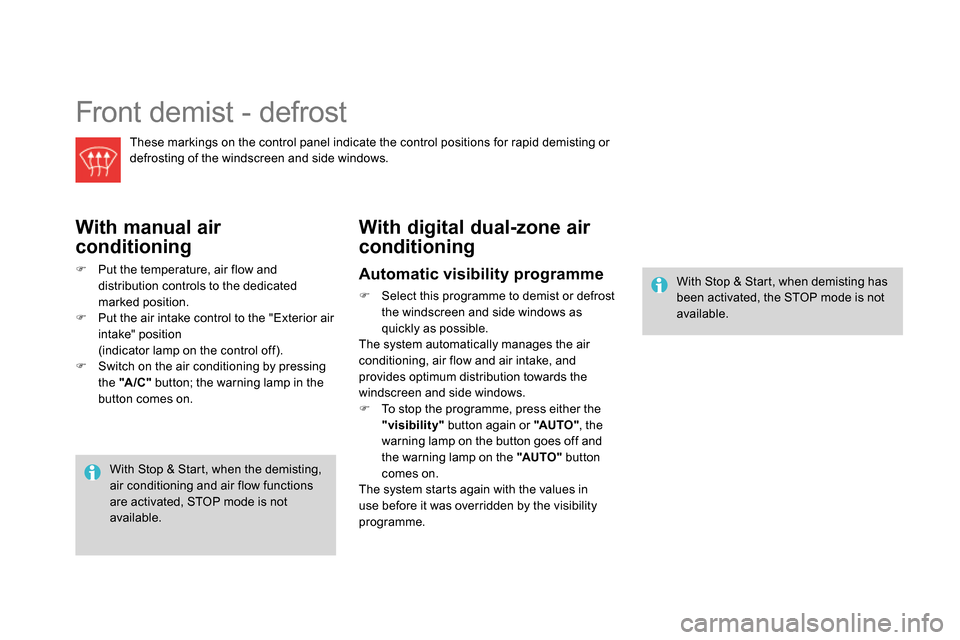
Front demist - defrost
These markings on the control panel indicate the control positions for rapid demisting or
defrosting of the windscreen and side windows.
With manual air
conditioning
Put the temperature, air flow and
distribution controls to the dedicated
marked position.
Put the air intake control to the "Exterior air
intake" position
(indicator lamp on the control off).
Switch on the air conditioning by pressing
the "A /C "
button; the warning lamp in the
button comes on.
With digital dual-zone air
conditioning
With Stop & Start, when the demisting,
air conditioning and air flow functions
are activated, STOP mode is not
available.
Automatic visibility programme
Select this programme to demist or defrost
the windscreen and side windows as
quickly as possible.
The system automatically manages the air
conditioning, air flow and air intake, and
provides optimum distribution towards the
windscreen and side windows.
To stop the programme, press either the
"visibility"
button again or "AUTO "
, the
warning lamp on the button goes off and
the warning lamp on the "AUTO "
button
comes on.
The system starts again with the values in
use before it was overridden by the visibility
programme.
With Stop & Start, when demisting has
been activated, the STOP mode is not
available.
Page 95 of 400
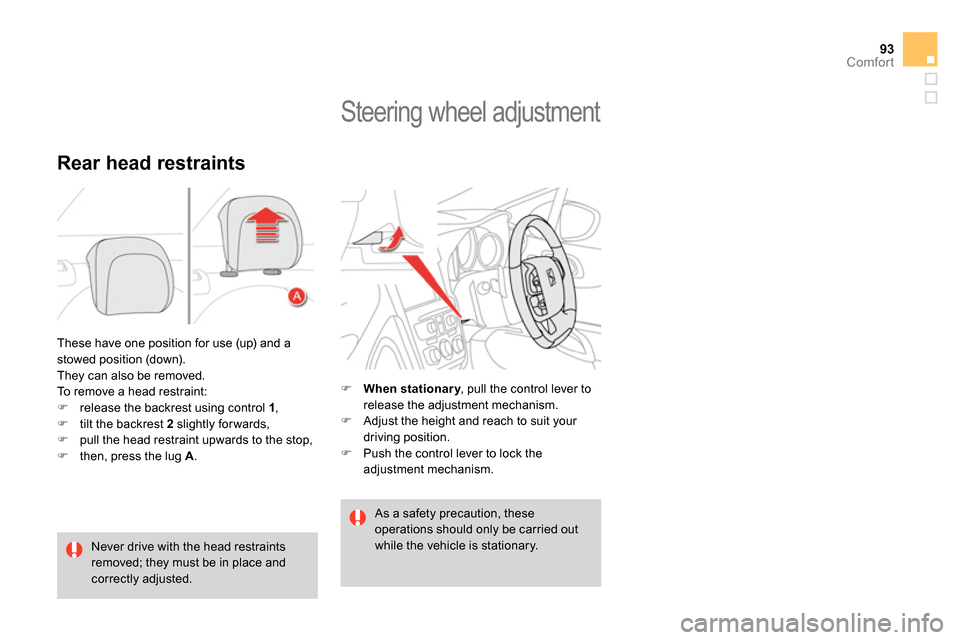
93Comfort
These have one position for use (up) and a
stowed position (down).
They can also be removed.
To remove a head restraint:
release the backrest using control 1
,
tilt the backrest 2
slightly forwards,
pull the head restraint upwards to the stop,
then, press the lug A
.
Rear head restraints
Never drive with the head restraints
removed; they must be in place and
correctly adjusted.
Steering wheel adjustment
When stationary
, pull the control lever to
release the adjustment mechanism.
Adjust the height and reach to suit your
driving position.
Push the control lever to lock the
adjustment mechanism.
As a safety precaution, these
operations should only be carried out
while the vehicle is stationary.
Page 104 of 400
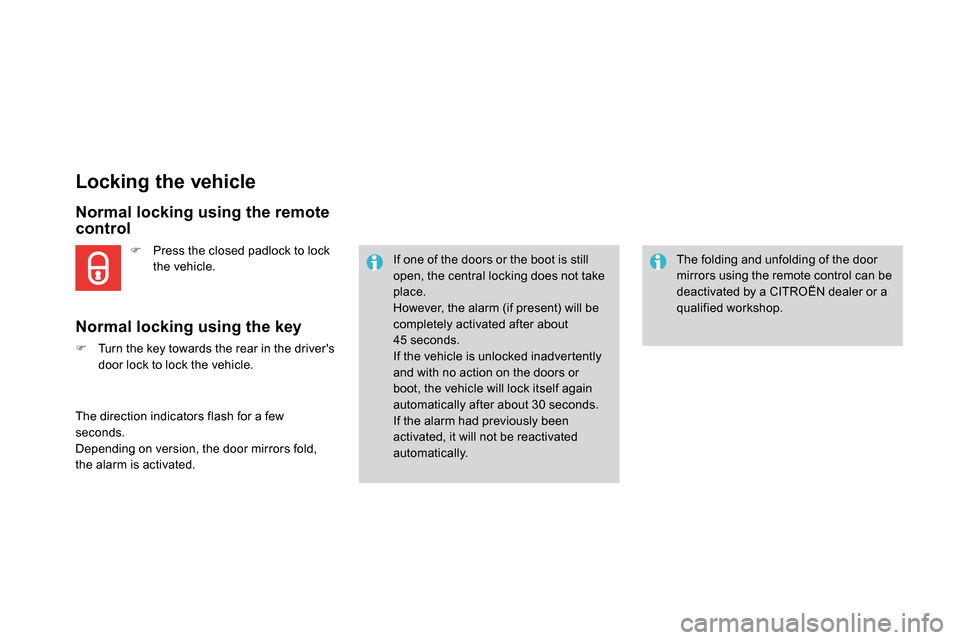
Locking the vehicle
Normal locking using the remote
control
Normal locking using the key
Turn the key towards the rear in the driver's
door lock to lock the vehicle.
Press the closed padlock to lock
the vehicle.
If one of the doors or the boot is still
open, the central locking does not take
place.
However, the alarm (if present) will be
completely activated after about
45 seconds.
If the vehicle is unlocked inadvertently
and with no action on the doors or
boot, the vehicle will lock itself again
automatically after about 30 seconds.
If the alarm had previously been
activated, it will not be reactivated
automatically.
The folding and unfolding of the door
mirrors using the remote control can be
deactivated by a CITROËN dealer or a
qualified workshop.
The direction indicators flash for a few
seconds.
Depending on version, the door mirrors fold,
the alarm is activated.
Page 107 of 400
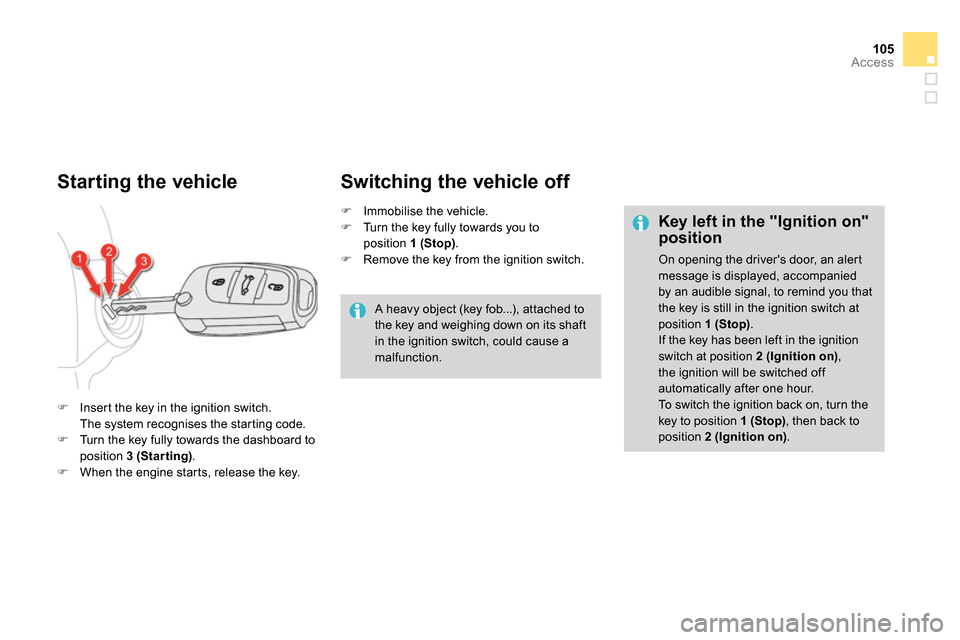
105Access
Starting the vehicle
Insert the key in the ignition switch.
The system recognises the starting code.
Turn the key fully towards the dashboard to
position 3 (Star ting)
.
When the engine starts, release the key.
Immobilise the vehicle.
Turn the key fully towards you to
position 1 (Stop)
.
Remove the key from the ignition switch.
Switching the vehicle off
A heavy object (key fob...), attached to
the key and weighing down on its shaft
in the ignition switch, could cause a
malfunction.
Key left in the "Ignition on"
position
On opening the driver's door, an alert
message is displayed, accompanied
by an audible signal, to remind you that
the key is still in the ignition switch at
position 1 (Stop)
.
If the key has been left in the ignition
switch at position 2 (Ignition on)
,
the ignition will be switched off
automatically after one hour.
To switch the ignition back on, turn the
key to position 1 (Stop)
, then back to
position 2 (Ignition on)
.
Page 113 of 400
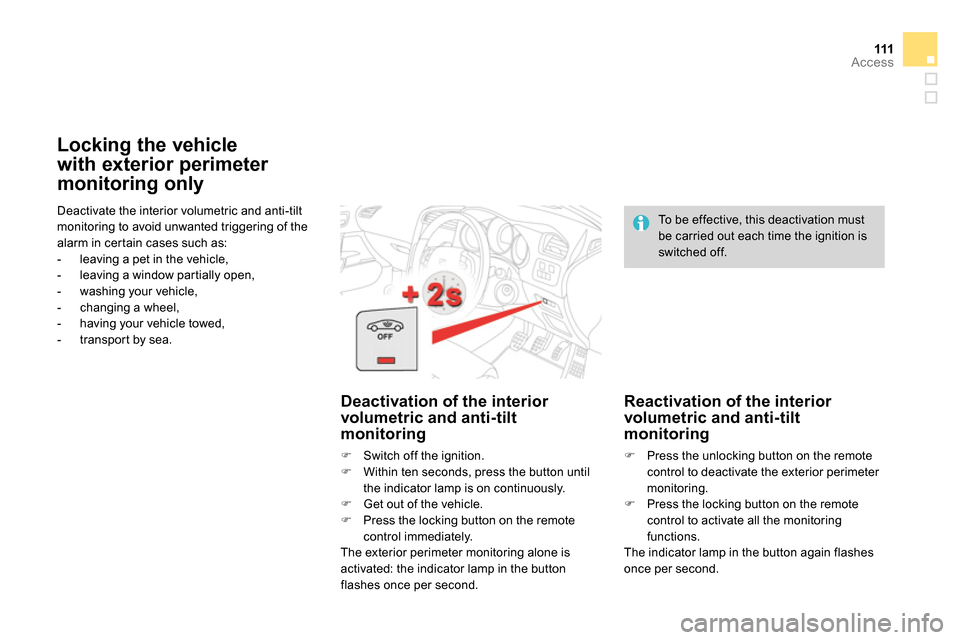
111Access
Deactivate the interior volumetric and anti-tilt
monitoring to avoid unwanted triggering of the
alarm in certain cases such as:
- leaving a pet in the vehicle,
- leaving a window partially open,
- washing your vehicle,
- changing a wheel,
- having your vehicle towed,
- transpor t by sea.
Locking the vehicle
with exterior perimeter
monitoring only
Deactivation of the interior
volumetric and anti-tilt
monitoring
Switch off the ignition.
Within ten seconds, press the button until
the indicator lamp is on continuously.
Get out of the vehicle.
Press the locking button on the remote
control immediately.
The exterior perimeter monitoring alone is
activated: the indicator lamp in the button
flashes once per second. To be effective, this deactivation must
be carried out each time the ignition is
switched off.
Reactivation of the interior
volumetric and anti-tilt
monitoring
Press the unlocking button on the remote
control to deactivate the exterior perimeter
monitoring.
Press the locking button on the remote
control to activate all the monitoring
functions.
The indicator lamp in the button again flashes
once per second.
Page 116 of 400
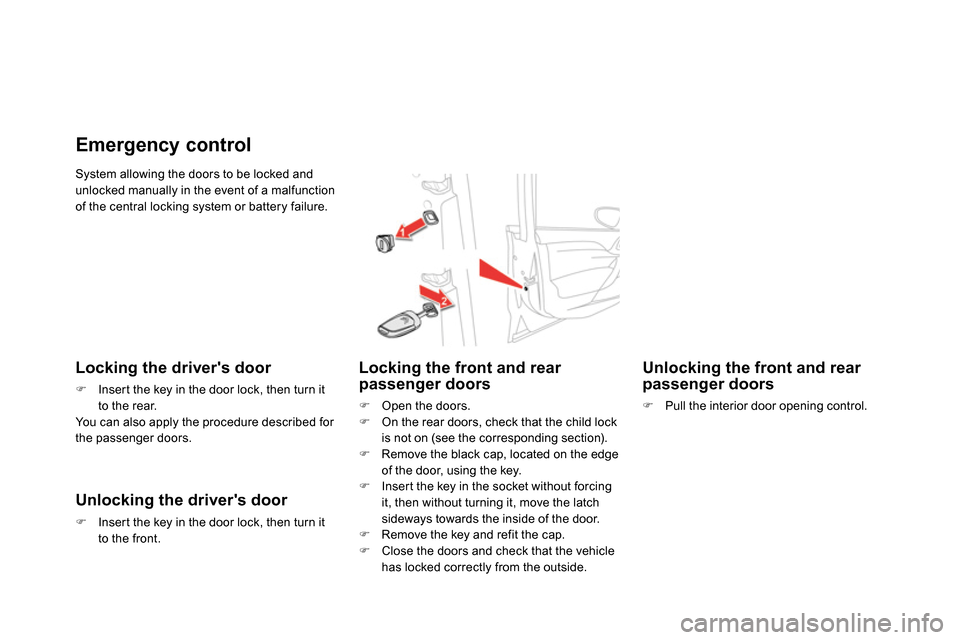
System allowing the doors to be locked and
unlocked manually in the event of a malfunction
of the central locking system or battery failure.
Emergency control
Locking the driver's door
Insert the key in the door lock, then turn it
to the rear.
You can also apply the procedure described for
the passenger doors.
Unlocking the driver's door
Insert the key in the door lock, then turn it
to the front.
Locking the front and rear
passenger doors
Open the doors.
On the rear doors, check that the child lock
is not on (see the corresponding section).
Remove the black cap, located on the edge
of the door, using the key.
Insert the key in the socket without forcing
it, then without turning it, move the latch
sideways towards the inside of the door.
Remove the key and refit the cap.
Close the doors and check that the vehicle
has locked correctly from the outside.
Unlocking the front and rear
passenger doors
Pull the interior door opening control.
Page 120 of 400
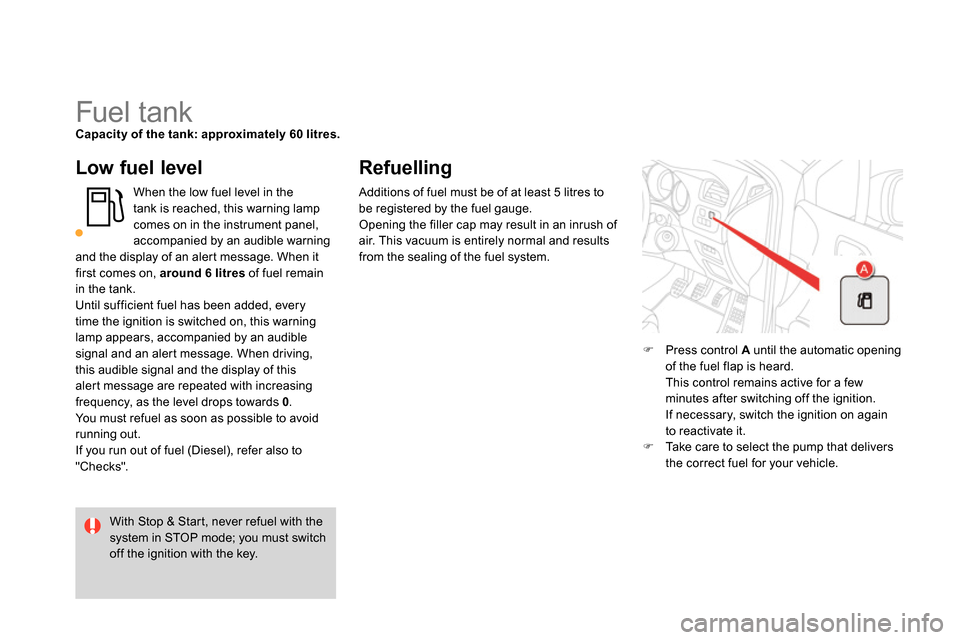
Fuel tank
Capacity of the tank: approximately 60 litres.
Low fuel level
When the low fuel level in the
tank is reached, this warning lamp
comes on in the instrument panel,
accompanied by an audible warning
and the display of an alert message. When it
first comes on, around 6 litres
of fuel remain
in the tank.
Until sufficient fuel has been added, every
time the ignition is switched on, this warning
lamp appears, accompanied by an audible
signal and an alert message. When driving,
this audible signal and the display of this
alert message are repeated with increasing
frequency, as the level drops towards 0
.
You must refuel as soon as possible to avoid
running out.
If you run out of fuel (Diesel), refer also to
"Checks".
Refuelling
Press control A
until the automatic opening
of the fuel flap is heard.
This control remains active for a few
minutes after switching off the ignition.
If necessary, switch the ignition on again
to reactivate it.
Take care to select the pump that delivers
the correct fuel for your vehicle.
With Stop & Start, never refuel with the
system in STOP mode; you must switch
off the ignition with the key. Additions of fuel must be of at least 5 litres to
be registered by the fuel gauge.
Opening the filler cap may result in an inrush of
air. This vacuum is entirely normal and results
from the sealing of the fuel system.
Page 127 of 400
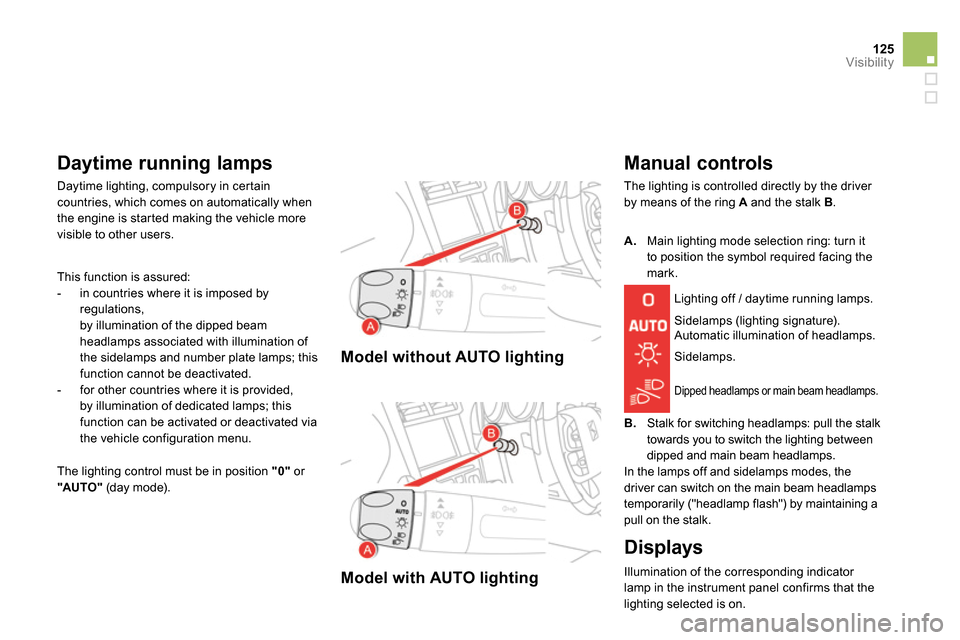
125Visibility
Model without AUTO lighting
Model with AUTO lighting
Manual controls
The lighting is controlled directly by the driver
by means of the ring A
and the stalk B
.
Sidelamps (lighting signature).
Automatic illumination of headlamps.
B.
Stalk for switching headlamps: pull the stalk
towards you to switch the lighting between
dipped and main beam headlamps.
In the lamps off and sidelamps modes, the
driver can switch on the main beam headlamps
temporarily ("headlamp flash") by maintaining a
pull on the stalk.
A.
Main lighting mode selection ring: turn it
to position the symbol required facing the
mark.
Lighting off / daytime running lamps.
Sidelamps.
Dipped headlamps or main beam headlamps.
Displays
Illumination of the corresponding indicator
lamp in the instrument panel confirms that the
lighting selected is on. Daytime lighting, compulsory in certain
countries, which comes on automatically when
the engine is started making the vehicle more
visible to other users.
This function is assured:
- in countries where it is imposed by
regulations,
by illumination of the dipped beam
headlamps associated with illumination of
the sidelamps and number plate lamps; this
function cannot be deactivated.
- for other countries where it is provided,
by illumination of dedicated lamps; this
function can be activated or deactivated via
the vehicle configuration menu.
Daytime running lamps
The lighting control must be in position "0"
or
"AUTO "
(day mode).
Page 135 of 400
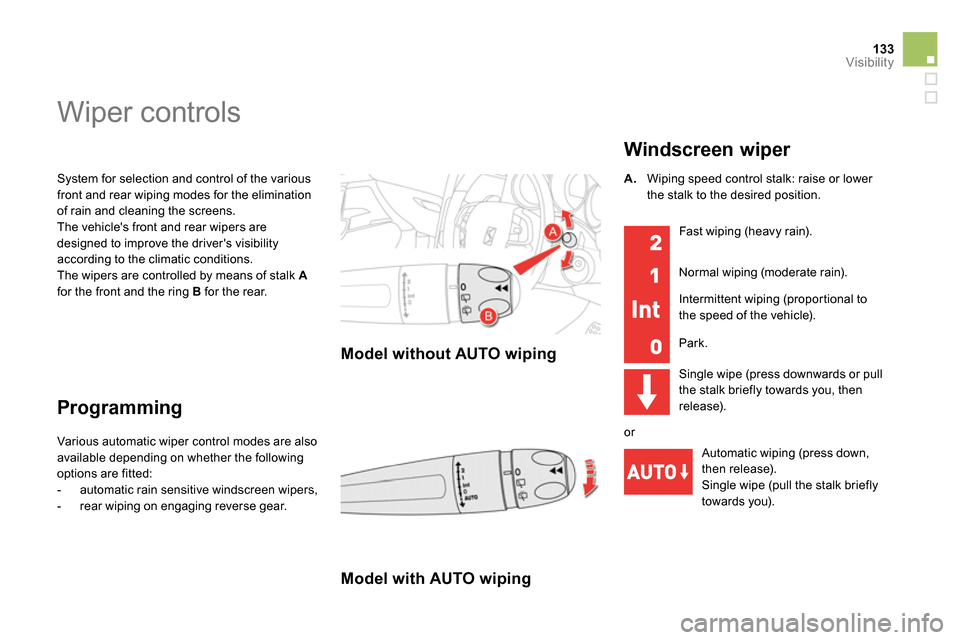
133Visibility
System for selection and control of the various
front and rear wiping modes for the elimination
of rain and cleaning the screens.
The vehicle's front and rear wipers are
designed to improve the driver's visibility
according to the climatic conditions.
The wipers are controlled by means of stalk A
for the front and the ring B
for the rear.
Wiper controls
Programming
Model without AUTO wiping
Various automatic wiper control modes are also
available depending on whether the following
options are fitted:
- automatic rain sensitive windscreen wipers,
- rear wiping on engaging reverse gear.
Model with AUTO wiping
Windscreen wiper
A.
Wiping speed control stalk: raise or lower
the stalk to the desired position.
Single wipe (press downwards or pull
the stalk briefly towards you, then
release).
Automatic wiping (press down,
then release).
Single wipe (pull the stalk briefly
towards you). Fast wiping (heavy rain).
Normal wiping (moderate rain).
Intermittent wiping (proportional to
the speed of the vehicle).
Park.
or
Page 137 of 400
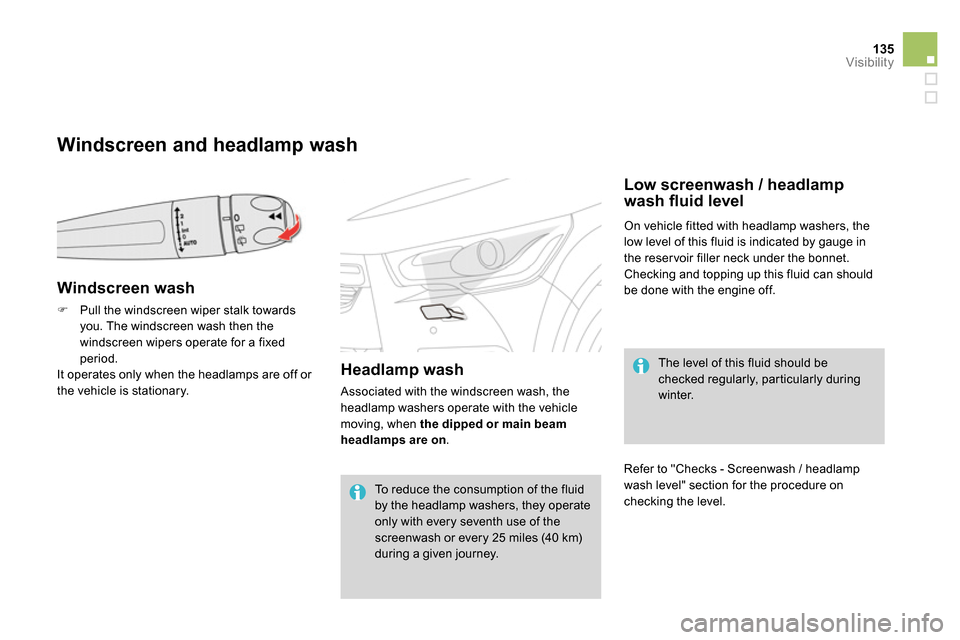
135Visibility
Windscreen and headlamp wash
Windscreen wash
Pull the windscreen wiper stalk towards
you. The windscreen wash then the
windscreen wipers operate for a fixed
period.
It operates only when the headlamps are off or
the vehicle is stationary.
Low screenwash / headlamp
wash fl uid level
On vehicle fitted with headlamp washers, the
low level of this fluid is indicated by gauge in
the reservoir filler neck under the bonnet.
Checking and topping up this fluid can should
be done with the engine off.
The level of this fluid should be
checked regularly, particularly during
winter.
Refer to "Checks - Screenwash / headlamp
wash level" section for the procedure on
checking the level.
Headlamp wash
Associated with the windscreen wash, the
headlamp washers operate with the vehicle
moving, when the dipped or main beam
headlamps are on
.
To reduce the consumption of the fluid
by the headlamp washers, they operate
only with every seventh use of the
screenwash or every 25 miles (40 km)
during a given journey.